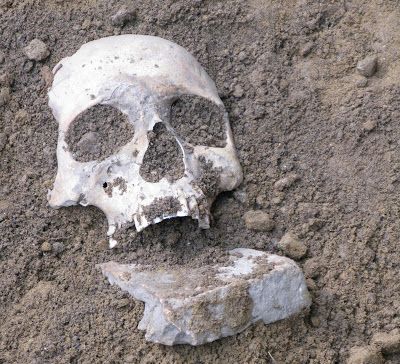Eight centuries of history have shown that some scholars have been found with large piles of stones stuffed into their mouths, something researchers believe was done by locals to prevent the dead from returning to walk the Earth as zombies.
The research began more than six years ago on what was supposed to be a study of medieval churches in County Roscommon, Ireland.

“One of the discoveries that were found in Ireland with rocks dipped in their mouths turning them into zombies. Discovery: One of the selections that were found in Ireland with rocks dipped in their mouths to prevent them from turning into zombies. He said that two male selections, one between 40 and 60 years old, and the other a young adult probably in his twenties, had been found among hundreds of other remains.

“One of them was lying with his head facing upwards. A large black stone had been deliberately placed in his mouth.
“The other one had its head turned to one side and had an even larger stone forced quite violently into its mouth, so that its jaws were almost dislocated,” he told Discovery News.
The two men were lying next to each other and were discovered together.”

The team first thought they had stumbled upon a Black Death cemetery when remains of people buried in the late Middle Ages had stones stuck in their mouths because they were involved in vampire-slaying rituals.
It is believed that around 3,000 skeletons buried between 700 and 1400 are still buried at the site.
The belief that zombies cannot return from the grave as the undead has its roots in Haitian culture, where it is linked to voodoo magic and witchcraft.
Superstition is so strong on the Caribbean island that relatives of the dead will dismember a corpse so that it cannot return as a zombie. Others will stand guard over a grave to protect the body until decomposition begins.
According to believers, a zombie will rise from its grave in a hypnotic trance, able to respond to stimuli but lacking self-awareness.
Initially, archaeologists believed that the ritual of placing a stone in the mouth could be related to vampire killing, in which a stake is driven through the victim’s heart. Vampires were believed to spread plague and were thought to place a stone inside their mouth to prevent this. Practitioners also believed that placing a stone in the mouth of a corpse would starve it to death.
In 2009, the remains of a 60-year-old woman with a rock in her mouth were discovered in a 16th-century mass grave on the Venetian island of Lazzaretto Nuovo. But vampire culture did not evolve until the 16th century, and so cannot explain why rocks were found on skeletons dating back to the 8th century.
“In this case, the stones in the mouth may have acted as a barrier to prevent the revenants from returning from their graves,” Dr Read said.
The skeleton of a “vampire” buried in the 16th century has been discovered as an exhibit in a museum.
Two years ago a collection of bones was discovered in northern Poland that bore the telltale marks of a vampire burial ritual. Experts examined the remains of a man found at the end of an ancient cemetery in the Pomeranian town of Kamiensk.
Now, they have been presented as the main attraction at the Kamiensk Museum of Earth History, while the organizers are preparing an exclusive exhibition just for the vampire. The body was found with a stake stuck in its leg and a small stone in its mouth.
Vampire “experts” said the stake was placed in the body’s mouth to prevent it from biting or sucking blood from its victims. And the pierced rib and femur, usually with iron spikes, were done to prevent the vampire from leaving its grave.




